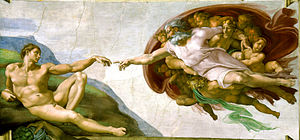Italian Renaissance

The Italian Renaissance (Italian: Rinascimento [rinaʃʃiˈmento]) was the earliest beginning of the general European Renaissance. It was a period of great cultural change and achievement that began in Italy during the 14th century.[1] It lasted into the 17th century, marking the gradual change between Medieval and Early Modern Europe.[1] The term "renaissance" is a modern one that was first used in 1858 by French historian Jules Michelet.[2] The Italian renaissance was a period of gradual change. Some parts can be traced back to the earlier part of the 14th century. Other parts did not happen until the end of the century. The French word renaissance (Rinascimento in Italian) means "Rebirth". The era is best known for the renewed interest in the culture of classical antiquity. While it started as a humanist movement it spread to other areas including science, religion, art and exploration.[3] During this period William Shakespeare wrote his plays, Leonardo da Vinci painted the Mona Lisa, and Martin Luther had started a new religious movement.[3] It saw Christopher Columbus discover the Americas and Johannes Gutenberg introduced printing to Europe.[3] The Italian "rebirth" gradually spread into Northern Europe.[4] As it moved northward, it changed into less a classical movement and more into a religious movement.[4]
References[change | change source]
- ↑ 1.0 1.1 "Italian Renaissance". History. A&E Television Networks, LLC. Retrieved December 19, 2016.
- ↑ Paul Johnson. "The Renaissance A Short History". The New York Times. Retrieved December 19, 2016.
- ↑ 3.0 3.1 3.2 "Italian Renaissance". World History. Go Social Studies Go. Archived from the original on December 18, 2016. Retrieved December 19, 2016.
- ↑ 4.0 4.1 James Riley Estep, C.E.: The Heritage of Christian Education (Joplin, MO: College Press Publishing Company, 2003), p. 8-3
